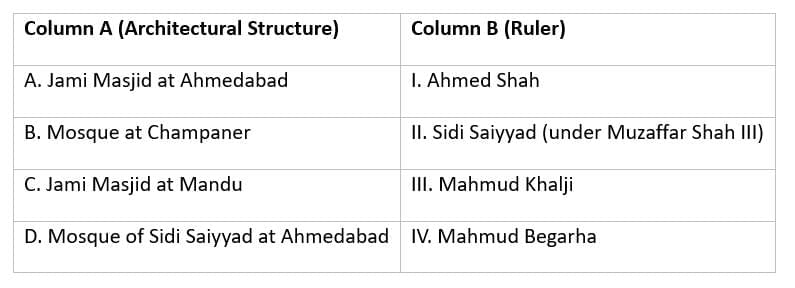Test: Indo Islamic Culture - 2 - UPSC MCQ
30 Questions MCQ Test - Test: Indo Islamic Culture - 2
Which Delhi sultan built a mosque on the dargah of Nizamuddin Auliya?
The double dome is a significant feature of the tomb of
Match the following provincial architectural structure with the rulers who built them:

The Atala Devi masjid and the Lal-Darwaza mosque were built by the Sharqis who ruled over
The most ambitious structure of its kind ever raised in eastern India was the Adina Masjid at Pandua. It was built by
The Dakhil Darwaza is a striking form of the Bengal style of architecture. It is to be found in the ruins of
In which province brick and timber were the principal building materials?
Which of the following provinces was a seat of Hindu craftsmanship?
The tall curved spiral roof and the mandapam (ante-room) were features of which style of architecture?
Match the following architectural works with the centuries in which they were built:
Mitakshara was a famous Hindu school of law.It is associated with
Match the following works with their authors who wrote in Sanskrit:
In about A.D. 1300, a number of works on the Mimamsa were written by
Lakshmidhara wrote Smritikalpataru . Its subject matter is
Vidagha Madhava and Lalita Madhava were written by
Smriti literature flourished in Mithila and Bengal. Two of its outstanding authors were :
Which of the following was a famous commentator on the Vedas?
In the domain of literature the greatest gift on the Muslims is
Which city emerged as the first centre for the cultivation of the Persian language?
The Hindu work, Khaliq Bari, is often atributed to
Which of the following Sanskrit scholars wrote Rajavinoda, a biography of Sultan Mahmud Begarha of Gujarat?
Which of the following were responsible for introducing a change in Jain miniature paintings by the fifteenth century by introducing paper?
The book Tuti Name (Book of the Parrot), written in the time of Muhammad Tughlaq, became popular and was translated from Persian into Turkish. Its author was
Who got Rajtarangani and Mahabharata translated into Persian?



















